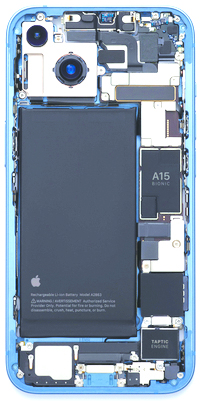Apple announced a major acceleration of its work to expand recycled materials across its products, including a new 2025 target to use 100 percent recycled cobalt in all Apple-designed batteries. Additionally, by 2025, magnets in Apple devices will use entirely recycled rare earth elements, and all Apple-designed printed circuit boards will use 100 percent recycled tin soldering and 100 percent recycled gold plating.
In 2022, the company significantly expanded its use of key recycled metals, and now sources over two-thirds of all aluminum, nearly three-quarters of all rare earths, and more than 95 percent of all tungsten in Apple products from 100 percent recycled material. This rapid progress brings Apple closer to its aim to one day make all products with only recycled and renewable materials, and advances the company’s 2030 goal to make every product carbon neutral.
“Every day, Apple is innovating to make technology that enriches people’s lives, while protecting the planet we all share,” said Tim Cook, Apple’s chief executive officer. “From the recycled materials in our products, to the clean energy that powers our operations, our environmental work is integral to everything we make and to who we are. So we’ll keep pressing forward in the belief that great technology should be great for our users, and for the environment.”
“Our ambition to one day use 100 percent recycled and renewable materials in our products works hand in hand with Apple 2030: our goal to achieve carbon neutral products by 2030,” said Lisa Jackson, Apple’s vice president of Environment, Policy, and Social Initiatives. “We’re working toward both goals with urgency and advancing innovation across our entire industry in the process.
Apple has significantly expanded the use of 100 percent certified recycled cobalt over the past three years, making it possible to include in all Apple-designed batteries by 2025. In 2022, a quarter of all cobalt found in Apple products came from recycled material, up from 13 percent the previous year. Cobalt is a critical material in the batteries used in most consumer electronics, including Apple devices, enabling high energy density while also meeting Apple’s robust standards for longevity and safety. Apple-designed batteries found in iPhone, iPad, Apple Watch, MacBook, and many other products represent a significant majority of the company’s use of cobalt.
The company’s use of 100 percent certified recycled rare earth elements has greatly expanded in the last year as well, going from 45 percent in 2021 to 73 percent in 2022. Since first introducing recycled rare earths in the Taptic Engine of iPhone 11, Apple has expanded its use of the material across its devices, including in all magnets found in the latest iPhone, iPad, Apple Watch, MacBook, and Mac models. As magnets are by far Apple’s largest use of rare earths, the new 2025 target means nearly all rare earths in Apple products will soon be 100 percent recycled.
As part of the accelerated new timeline, all Apple-designed printed circuit boards will use 100 percent certified recycled gold plating by 2025. This includes rigid boards, such as the main logic board, and flexible boards, like those connecting to the cameras or buttons in iPhone. Since pioneering an exclusively recycled supply chain for gold in the plating of the main logic board for iPhone 13, Apple has extended the material’s use in additional components and products, including the wire of all cameras in the iPhone 14 lineup, and printed circuit boards of iPad, Apple Watch, AirPods Pro, MacBook Pro, Mac mini, and HomePod. Apple is also working to encourage broader adoption of recycled gold for non-custom components across the electronics industry.
By 2025, the company will use 100 percent certified recycled tin soldering on all Apple-designed printed rigid and flexible circuit boards. In recent years, Apple’s use of recycled tin has expanded to the solder of many flexible printed circuit boards across Apple products, with 38 percent of all tin used last year coming from recycled sources. The application of recycled tin across even more components is underway, and the company is engaging more suppliers in this effort.
Innovation has also driven progress toward another of Apple’s 2025 commitments: to eliminate plastics from the company’s packaging. The development of fiber alternatives for packaging components like screen films, wraps, and foam cushioning has kept Apple on track toward this ambitious goal. To address the remaining 4 percent plastic in the company’s packaging footprint, Apple is innovating to replace labels, lamination, and other small uses. In the last year, Apple developed a custom printer to introduce digital printing directly onto the boxes of iPhone 14 and iPhone 14 Pro, eliminating the need for most labels. And a new overprint varnish found in iPad Air, iPad Pro, and Apple Watch Series 8 packaging replaces the polypropylene plastic lamination found on boxes and packaging components. The innovation helped avoid over 1,100 metric tons of plastic and over 2,400 metric tons of carbon dioxide.